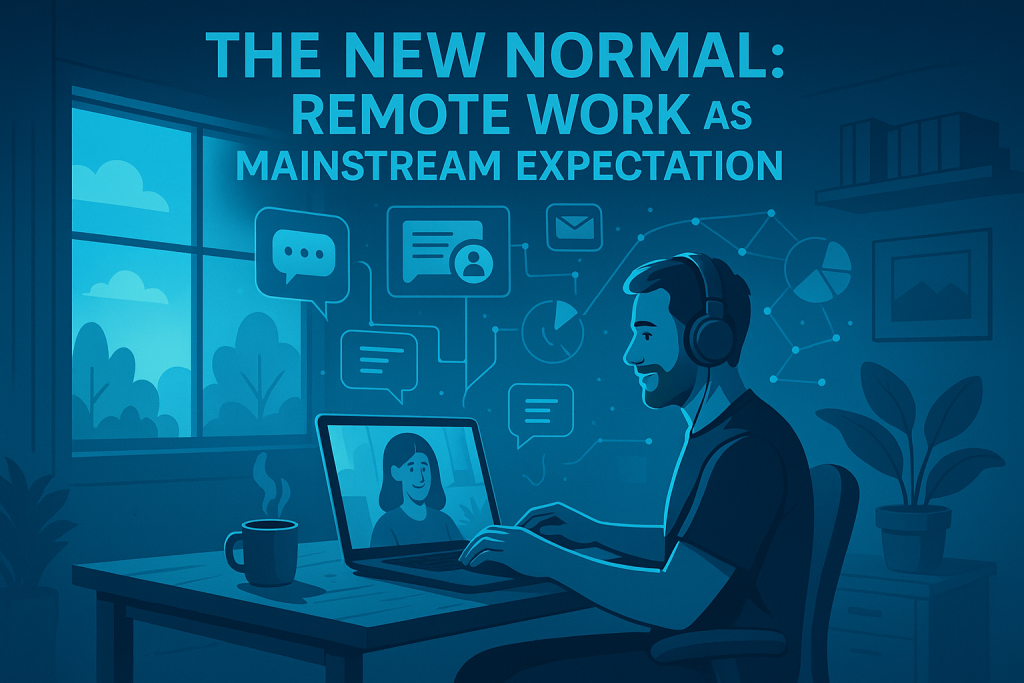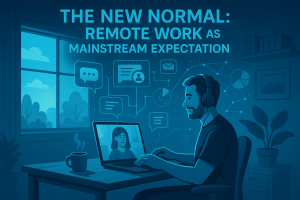The New Normal: Remote Work as Mainstream Expectation

Remote Work

The New Normal: Remote Work as Mainstream Expectation In 2025, Remote Work is no longer a novelty or perk—it’s become a baseline expectation for many employees and employers. Reports indicate that knowledge-industry workers, especially in tech, finance, and professional services, are increasingly demanding flexibility in when and where they work. According to Robert Half, about 88% of U.S. employers now offer some hybrid work options, and nearly a quarter of new job postings are hybrid, while fully remote roles are also present but less common. Robert Half+1. Read More : Destination Animal: Wonders—Exploring the World’s Most Unique Wildlife Sites
Employees’ preferences have shifted: for many, the ability to work remotely part of the week is just as important as salary or title. This changes the hiring landscape dramatically and forces companies to redesign their policies, culture, and measurement of success.
Hybrid Models: Bridging Remote Work and In-Person Connection

Hybrid models in 2025 are emerging as the sweet spot between fully remote and fully office-based work. Many organizations are adopting structured hybrid schedules—commonly two to three days in the office, the rest remote — to balance collaboration, team building, and innovation with flexibility and autonomy. Meetlytic+3MySeat+3Robert Half+3. Read More : Exploring Exclusive Perks with Amex Travel: What You Need to Know in 2024
Why this blend? Remote Work gives employees fewer commutes, more flexible lives, and access to global talent pools. At the same time, in-person days provide spontaneous interaction, mentorship, social bonding, and a culture anchor that pure remote setups often struggle to maintain. Hybrid models are helping companies hedge risk: maintaining the benefits of Remote Work without giving up entirely on community, cohesion, and collective identity.
Technology: Enabling the Future of Remote & Hybrid Teams

One of the biggest enablers of the 2025 Remote Work + hybrid era is technology innovation. AI tools are streamlining workflows—automating routine tasks, assisting with communication across time zones, transcribing meetings, and even offering virtual assistants to help schedule or prioritize work. KonexusHub+2OpsMatters+2
Virtual collaboration platforms are being enhanced—VR/AR environments, immersive virtual “offices”, advanced shared workspaces—so people feel connected even when they aren’t physically co-located. Tools that allow asynchronous work are also more mature, letting teams spread out hours while still collaborating effectively. These advances are helping mitigate some of the biggest challenges of Remote Work: isolation, miscommunication, and uneven visibility for remote contributors. Read More : Exploring the World: 10 Must-Visit Destinations for Adventure Enthusiasts
Culture, Well-Being, and Equity in Hybrid Environments

As Remote Work becomes standard, companies are realizing that flexible schedules bring both opportunities and pitfalls. On one side, employees enjoy better work-life balance: less commuting, more control over their day, greater ability to integrate personal needs. OpsMatters+2KonexusHub+2
But there are risks: burnout from blurred boundaries, loneliness, “always-on” expectations, and the danger of remote workers being less visible or having fewer promotion possibilities. Companies are responding by creating policies to protect well-being: mandatory “offline” times, wellness stipends, mental health resources, guidelines for meeting load, and redesigning leadership evaluation away from hours or presence toward outcomes and results. Inclusion is more than lip service — ensuring that remote workers aren’t overlooked in decision-making or in cultural events is becoming a priority. Zilker Partners+2Meetlytic+2
Hybrid models are not just changing where people work, but how organizations operate. Businesses are adjusting real estate portfolios, downsizing or repurposing physical office spaces into collaboration hubs, while also investing in tools and infrastructure to support distributed teams. Brimco+2Building Business News+2
Talent acquisition strategies are also evolving. Remote Work has opened access to global candidates, reducing geographic constraints. This increases competition among companies to offer not just pay but flexibility, culture, technology, and opportunities for growth. Hybrid arrangements help strike a balance: enabling companies to tap into global talent while maintaining some central points of contact. Read More : Family Bonds and Thrills: Exploring Family-Friendly Adventure Vacations
In addition, the measurement of performance is shifting. Success is less about being visible in an office and more about measurable outcomes, deliverables, impact. This demands trust, clarity of goals, strong communication, and metrics that truly reflect contribution.
Challenges and Adaptations in the Remote Work & Hybrid Era

Despite the positive shifts, there are headwinds. Some companies are experiencing “hybrid creep”— gradual increases in required in-office days as leadership pushes back toward more traditional structures. Business Insider
Cybersecurity threats rise when work is distributed. Data protection, secure access, endpoint security, and policy consistency become more complex. Remote Work setups require stringent security protocols. Medium+2Building Business News+2
Maintaining culture is another challenge: how do you onboard people, sustain mentorship, build trust, maintain shared values when team members seldom meet face to face? This demands intentional culture building, rituals (virtual and in person), and investment in relational time.
Meeting fatigue, scheduling across time zones, unequal visibility, and fairness in opportunities are practical issues that hybrid models must address. Read More : Will 2025 Finally Bring PayPal for Pakistan?






